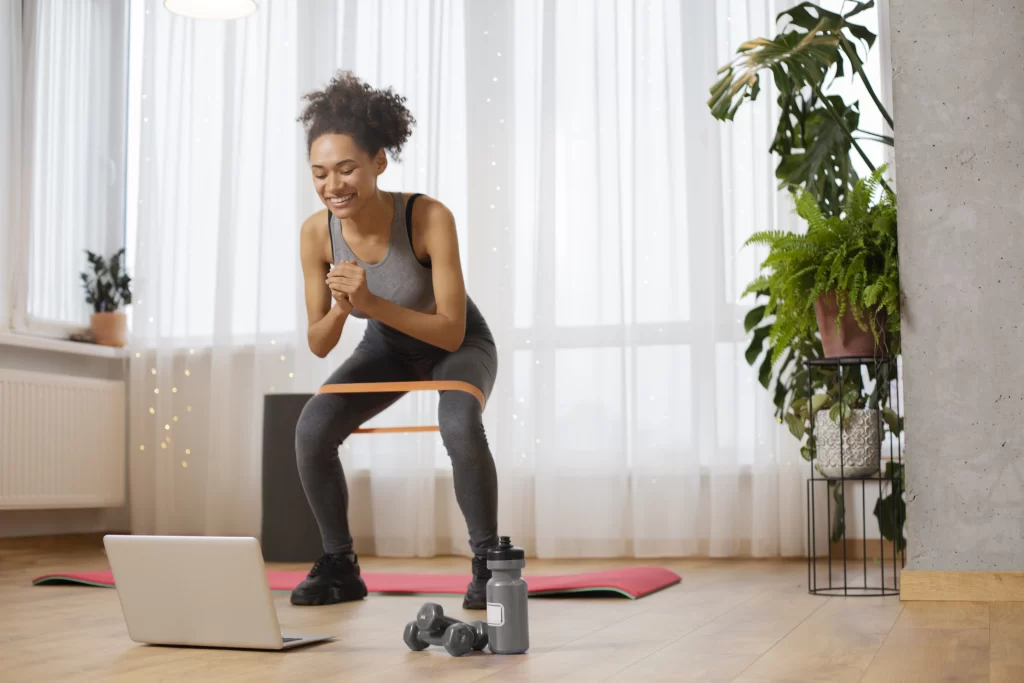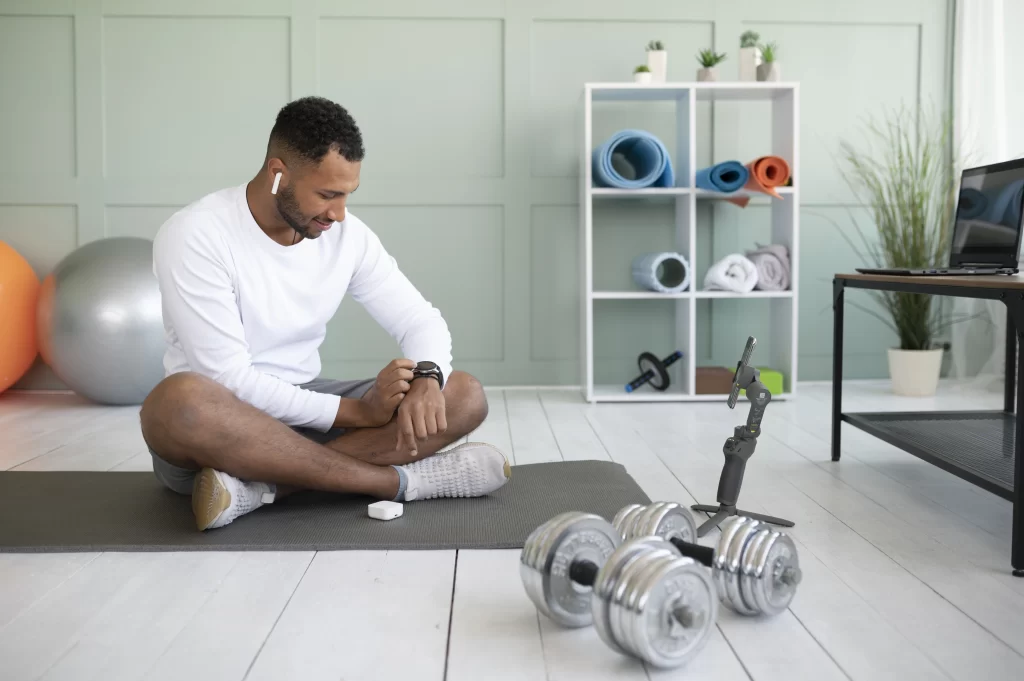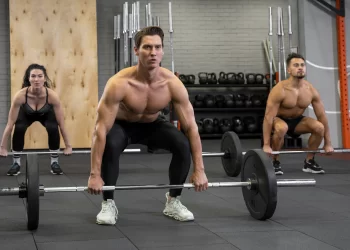Importance of Cardiovascular Exercise at Home
Cardiovascular exercise at home is crucial, especially in the current pandemic situation where people are confined to their homes. It helps in maintaining heart health, which is vital for the proper functioning of the human body. Engaging in cardiovascular exercises at home can be a viable and cost-effective option for those who cannot go to the gym or prefer not to exercise outside due to various reasons.
Indulging in cardiovascular exercises, such as walking, jogging, cycling, or swimming at home improves lung capacity and overall fitness levels. They help reduce weight, manage blood pressure levels, and improve sleep quality. Besides, these exercises increase the blood flow throughout your body leading to better heart health. People can easily incorporate different cardio exercises into their daily routines by using resistance bands or dumbbells.
Studies have found that performing a cardiovascular activity for 30 minutes a day lowers the risk of chronic diseases significantly. Regular physical activity increases HDL (good cholesterol) levels and decreases LDL (bad cholesterol), thus improving heart health. However, it’s important not to overexert yourself; you must listen to your body’s needs before engaging in any such activities.
Historically speaking, humanity has always engaged in physical activities for survival since ancient times when humans were hunter-gatherers; they used to move around following their prey on long runs hunting them down with nothing but their physical prowess and instincts. The introduction of machines led to an era where exercising wasn’t necessary anymore until athletic competitions started gaining popularity from the Victorian age onwards.
Therefore, it’s time we take matters into our own hands and indulge ourselves with simple yet effective workouts which keep our hearts strong without relying particularly on gyms or equipment as traditional medicines still believe “Prevention is better than cure“. Get your cardio fix without leaving your house (or your favorite Netflix show) with these heart-pumping exercises.
| Key Takeaways |
| Cardiovascular exercise at home is crucial for heart health during the pandemic. |
| Exercises like walking, jogging, cycling, and swimming improve fitness and weight management. |
| Regular cardio lowers the risk of chronic diseases and improves heart health. |
| Resistance training at home builds muscle and improves performance. |
| Customize your routine and incorporate variety for better results. |
| Rest and listen to your body to avoid overexertion. |
| Monitoring progress and setting realistic goals keeps you motivated. |
| Proper technique and form prevent injuries. |
| Hydration and rest between sessions are important. |
| Consistency in your routine improves overall well-being. |
| Short bursts of exercise throughout the day are beneficial. |
| Consult a doctor for pre-existing conditions. |
| Adjust your routine based on progress. |
| Warm-up and cool-down to prevent injuries. |
| Rest when needed and incorporate stretching for recovery. |
| Set achievable goals and track progress. |
| Journaling and rewards enhance motivation. |
Types of Cardiovascular Exercise at Home
To keep your cardiovascular system in good condition at home, you need to know the right types of exercise. That’s where “Types of Cardiovascular Exercise at Home” with “Aerobic Exercise” and “Anaerobic Exercise” comes in. These sub-sections offer you the solution to get your daily dose of heart-healthy exercise at home.
Aerobic Exercise
Cardiovascular Training
Elevating the heart rate and increasing blood circulation for an extended period is known as Cardiovascular Training. This exercise helps enhance heart-lung efficiency, burns fat, boosts metabolism, improves cholesterol levels, and strengthens bones. At home, various types of cardio exercises can be performed.
One such kind of Cardiovascular Exercise at home is Jumping Jacks. It involves starting with feet together and hands by sides followed by a jump with spreading legs while clapping over the head, then back to the original position and repeat.
Skipping rope is another great cardiovascular exercise that can effectively raise your heart rate. You only require a skipping rope and space enough to carry out this exercise seamlessly.
High-Intensity Interval Training (HIIT) is a popular technique involving short bursts of intense workouts interposed with rest periods creating an afterburn effect on the body resembling that of weight lifting – prolonging calorie burning even after exercising.
Don’t miss out on these fun indoor exercises that offer great benefits! Incorporate some form of Cardiovascular training into your daily routine to take your fitness level up a notch.
Brisk walking – is the perfect way to get your heart rate up without having to run from your problems.
Brisk Walking
Walking at a brisk pace is a great way to engage in cardiovascular exercise at home in the outdoors. This moderate-intensity exercise can be done on various terrains, such as sidewalks or nature trails, and is perfect for beginners who are looking to stay active without putting too much strain on their joints.
Here’s a 3-step guide that can help you with Walking at a Brisk Pace:
- Begin by warming up your muscles with light stretching exercises for about 5 minutes.
- Walk at a moderate-to-high pace, swinging your arms naturally while keeping your head up and your eyes facing forward.
- Aim to walk for at least 30 minutes or more, increasing the speed and duration gradually over time.
Furthermore, this form of exercise helps improve cardiovascular health by reducing blood pressure, fat levels, and bad cholesterol while also increasing good cholesterol. Try incorporating different types of walking workouts into your routine, such as interval training or hill climbing. Stay hydrated throughout the workout by drinking plenty of water and wear comfortable shoes with proper support.
Did you know that regular brisk walking can reduce the risk of heart disease? A long-term study conducted in the UK found that individuals who walked regularly had lower rates of heart attack and stroke compared to those who didn’t engage in daily physical activity. Start taking steps towards better health today!
Lastly, it is not considered running away from your problems if you’re just jogging in place at home.
Jogging or Running in Place
For those wanting to engage in cardiovascular exercise at home, one option is what can be referred to as ‘Dynamic Stationary Running’. This involves jogging or running in place and can provide a challenging workout in the comfort of your own space.
- Requires minimal equipment – all you need is a pair of comfortable shoes and enough space to move around in.
- Can be modified for different levels of fitness and age groups – slower, low-impact movements may be better suited for beginners or older adults.
- Offers a variety of workout formats – intervals, high-intensity bursts, and steady-state endurance workouts can all be designed using this technique.
- Provides an opportunity for indoor exercising when outdoor conditions are not favorable or safe for physical activity.
It’s important to note that proper technique should always be prioritized with any form of exercise. Maintain good posture, engage your core muscles, and avoid slamming your heels into the ground to prevent joint impact.
One suggestion for incorporating this form of exercise into your routine could be starting with shorter sessions, and gradually increasing time duration or intensity as your body adapts. Another suggestion could be adding music or guided workouts to keep you motivated and on track with reaching your fitness goals.
Jogging or running in place may seem like a simple exercise but can offer many benefits for those looking to improve their cardiovascular health and overall fitness levels. Who needs a dance partner when you can boogie alone in your living room and get your heart pumping at the same time?
Dancing
Dancing is an excellent form of cardiovascular exercise that can be easily performed at home. This is my personal favorite.
- Different types of dancing can target various muscle groups and improve coordination and balance.
- The energetic moves involved in dancing raise the heart rate, which supports healthy circulation and burns calories.
- Dancing can boost mood, reduce stress, and promote relaxation through rhythmic movements and music.
- Learning a new dance style can provide a challenging cognitive workout for the brain and enhance memory retention.
Incorporating dancing into your exercise routine can offer numerous benefits beyond physical fitness. Dancers also enjoy increased confidence, self-expression, and creativity.
Studies have shown that dance therapy can improve psychological well-being in people with depression or anxiety disorders. With the convenience of online tutorials and virtual lessons, there are plenty of resources available to learn different styles of dancing from the comfort of your home.
According to Harvard Health Publishing, “Zumba is a fun way to burn calories,” as it incorporates salsa, merengue, hip-hop, and other styles into an aerobic workout.

Why run when you can lift and grunt your way to a healthier heart with anaerobic exercise at home?
Anaerobic Exercise
Power Up Your Cardiovascular Workouts with Explosive Exercise
Explosive exercise, also known as anaerobic exercise, is a great way to increase athletic power and build cardiovascular strength. Unlike steady-state exercises, explosive exercises rely on quick bursts of energy to achieve maximum power output.
Some popular examples of explosive exercises include plyometric jumps, kettlebell swings, and sprinting. You can easily engage in cardiovascular exercise at home using minimal equipment or simply relying on your body weight.
When engaging in explosive exercise, it’s important to warm up properly to prevent injuries. Proper form and concentration are also key since the movements can be intense. If you’re looking for a new challenge in your at-home workout routine, give explosive exercise a try.
Using high-intensity workouts may put untrained exercisers at risk for injury if they don’t slowly build up endurance. Start by doing shorter sets and gradually building up time and intensity over several weeks until good habits are established.
Incorporating explosive exercise into your fitness routine offers benefits such as improved muscular strength and power output, increased metabolic rate, and an overall boost in athleticism. Give it a try today!
Who needs a gym when you can get a workout just trying to open a stubborn jar? Welcome to the world of resistance training at home.
Resistance Training
Resistance Training is an essential cardiovascular exercise that can be performed at home. It involves using weights, resistance bands, or body weight to build muscle and endurance. Here are six points to consider for effective resistance training:
- Choose exercises that target different muscle groups
- Vary the resistance level to avoid muscle adaptation
- Combine resistance training with aerobic exercise
- Gradually increase the intensity and duration of your workout
- Avoid overtraining by allowing adequate rest between sessions
- Consult with a fitness professional for proper form and technique
Incorporating Resistance Training in your home workouts provides unique benefits such as maintaining or building muscle mass, improving bone density, and enhancing overall physical performance. Be sure to prioritize proper technique and gradually increase the intensity of your workouts.
I met Sarah, a former couch potato who incorporated Resistance Training into her home workouts, transforming her physique. She initially struggled with lifting weights but gradually increased her strength through consistent training. Now she enjoys incorporating Resistance Training into her daily routine for its numerous health benefits.

HIIT: Because sweating at home has never felt so good (and painful)
HIIT (High-Intensity Interval Training)
High-Intensity Interval Training, a type of cardiovascular exercise that involves short bursts of intense activity followed by rest periods, is a popular and effective workout technique.
- HIIT workouts typically last 20-30 minutes.
- They are known to burn more calories than steady-state cardio exercises like running or cycling.
- The intense bursts of activity increase heart rate, leading to improved cardiovascular endurance.
- HIIT can be done with various equipment such as dumbbells, resistance bands, or just bodyweight exercises.
- The flexibility of HIIT workouts allows them to be easily customized to the individual’s fitness level and goals.
Additionally, HIIT is also known for its ability to produce an afterburn effect where the body continues to burn calories long after the workout has ended.
Interestingly, HIIT has been around since the 1970s when it was primarily used by athletes for conditioning. It gained popularity in mainstream fitness during the early 2000s and has continued to be a staple in many people’s exercise routines today.
Get your heart racing and your sweat pouring with these easy-to-follow cardio exercises you can do in the comfort of your own home.
Cardiovascular Exercise at Home (Daily Routine)
To keep your cardiovascular system in check through an exercise routine at home, warm-up exercises, aerobic exercise routine, anaerobic exercise routine, and cool-down exercises are essential. These sub-sections help you prepare your body, increase your heart rate, and improve your blood flow to the muscles before commencing with HIIT routines, strength training, or other forms of cardio exercises, followed by proper cool-down exercises.
Warm-Up Exercises
Beginning a Cardiovascular Workout
A professional and informative explanation of the ‘Warm-Up Exercises’ phase within a cardiovascular workout routine.
Before commencing your cardiovascular at-home workout, it is essential to prepare your body to avoid injury and increase performance. The warm-up exercises are the first phase of your workout that help you prime your muscles for strenuous activity.
- Start with Muscular Stretching – Stretching helps to increase blood flow and flexibility in your muscles.
- Perform Low-Intensity Movements – Slow-paced aerobic movements like walking or jogging in place can elevate your heart rate.
- Incorporate Bodyweight Exercises – Include some Squats, Push-Ups, or Lunges to stimulate multiple muscle groups and boost calorie burning.
- Add Some Yoga Poses – Incorporate Yoga postures like Child’s Pose or Downward Dog can help loosen up tight muscles and alleviate any stress.
- Breathing Techniques – Incorporate deep breathing exercises as part of warm-up workouts; this helps oxygenate the blood and enhance calorie burn.
- Increased Range of Motion Exercises – Perform dynamic stretches such as arm circles or high knees to improve ease of movement.
It would also be beneficial if you could stretch any sore or stiff areas of the body. Overall, these exercises should never place too much strain but rather gently prepare the body for more intense activities coming up without causing damage.
Performing a Set Routine:
To achieve maximum benefits during your cardio routine, performing each set exercise by sequence will optimize caloric burn-off. It’s recommended to incorporate 3-4 sets targeting different areas of the body for 15-20 minutes daily.
Fun fact: Research from Medicine & Science in Sports & Exercise suggests stretching before an exercise can improve overall exercise satisfaction.
Get your heart racing without even leaving your living room with these aerobic exercises- no need to break a sweat searching for a gym!
Aerobic Exercise Routine
Regular physical activity can benefit the cardiovascular system. Here’s a simple, yet effective routine to get aerobic exercise at home:
- Start with a warm-up: March in place or do jumping jacks for 5 minutes to elevate your heart rate gradually.
- Engage in Moderate Intensity Activity: choose activities that increase your heart rate such as jogging or cycling indoors. Aim for at least 30 minutes of such activity.
- End with a cool-down: Slow down the intensity and complete the workout on a relaxed note by stretching for about 5-10 minutes.
For an extra challenge, add weights or interval training variations to your exercises.
Pro Tip- Try different types of exercise to avoid boredom and repetition and stay motivated, such as dancing, kickboxing, or swimming if you have a pool available.
Get ready to sweat like a pig and feel like a champion with our anaerobic exercise routine.
Anaerobic Exercise Routine
A High-Intensity Workout Routine
Get ready for an intense workout with our anaerobic exercise routine. This high-intensity workout focuses on building strength, endurance and improving overall physical fitness.
Here’s a 5-step guide to get started:
- Warm-up: Begin by warming up your body with some light cardio exercises like jumping jacks, running in place, or skipping rope.
- Strength Training: The next step is to focus on strength training exercises that target different muscle groups like squats, lunges, push-ups, and crunches.
- HITT Cardio: This is where the real work begins. Add a few rounds of HITT cardio exercises like burpees, mountain climbers, or jumping squats to burn maximum calories.
- Cool Down: Once you complete all these workouts, cool down your body with some stretches or yoga poses for at least 5-10 minutes.
- Repeat: For best results, repeat this entire routine at least three times a week.
To take things up a notch, try incorporating weights or resistance bands while doing strength training exercises. Additionally, don’t forget to stay hydrated throughout the workout routine.
Did you know that according to the American College of Sports Medicine (ACSM), adults should perform at least two days of resistance exercise per week? It’s essential to take care of our overall physical health by engaging in activities that benefit our bodies.
After all that cardio, a cool down is like a soothing hug for your heart.

Cool Down Exercises
After completing your cardiovascular exercise routine at home, it’s important to incorporate a series of gradual and calming Cool Down Techniques. Effective Cool Down Methods will help your body transition from a state of physical exertion to relaxation and reduce the risk of injury.
Here are six recommendations for your Cool-Down Exercises:
- Stretching: This can increase your range of motion, improve flexibility and decrease muscle soreness.
- Light Aerobic Exercise: These activities allow for a slow reduction in heart rate and body temperature.
- Foam Rolling: This technique helps release tension and knots in the muscles caused by the workout.
- Deep Breathing: By focusing on breathing, you can enhance oxygen circulation and lower blood pressure while calming your mind.
- Yoga Poses: Different Yoga Asanas help relax the body and mind by removing stress stored within
- Meditation: Spend time meditating immediately after exercising while sitting down or lying on the floor with some relaxing music playing in the background that could calm down any intensity left over by exercise.
Incorporating any combination of these exercises for around 5-10 minutes after completing your Cardio session will not only provide stabilization in recovery but also make sure our bodies don’t experience burnout.
Remember to listen to your body, and if an exercise causes discomfort or pain, stop immediately. Each individual’s cool-down needs may vary based on fitness levels or restrictions such as injuries.
Finally, I suggest choosing exercises depending on personal preference that work best for one’s muscle group targeting areas so that optimal performance could be attained throughout the day.
Who needs an expensive personal trainer when you can customize your cardio routine from the comfort of your own home?
Customizing Your Cardiovascular Exercise at Home Routine
To customize your cardiovascular exercise at home routine, focus on your needs. Setting realistic goals, monitoring progress, and making adjustments to your routine are solutions.
Setting Realistic Goals
At the outset, it is crucial to create pragmatic goals for your cardiovascular exercise regimen. The goals must incorporate feasible targets based on age, fitness level, and health conditions.
Consider factors such as duration, frequency, and intensity of your workout to set attainable targets. Use smart goal-setting techniques to determine achievable milestones that meet your individual capacity while ensuring continuous improvement.
In determining your fitness objectives, be mindful of the unique benefits cardio has on the heart, lungs, and overall healthfulness. To maximize these positive long-term outcomes, it’s prudent to monitor progress regularly and adjust goals accordingly.
Studies have shown that customizing a cardio routine can significantly improve overall physical functioning with time; this personalized approach using a wellness plan is scientifically proven to provide better results than following one-size-fits-all routines without accounting for individual differences.
It is well-documented that proper cardiovascular workouts have countless health benefits, including reduced risk of heart disease and stroke. According to the American Heart Association (AHA), only 150 minutes or less per week of moderate exercise or 75 minutes per week of vigorous activity will go a long way in keeping healthy individuals away from potential stroke attacks.
Tracking your progress is like being a detective for your heart health, but instead of clues, you’re looking for beats per minute.
Monitoring Progress
Keeping Track of Your Cardiovascular Exercise at Home Progress
To achieve the desired results from your cardiovascular workout routine, keeping track of the progress is crucial. A smart way to do this is by measuring the intensity and duration of each workout and documenting them in a journal or fitness app.
By monitoring your progress regularly, you can identify any gaps in your performance and bring the required adjustments to meet your fitness goals. Also, keeping a record of your accomplishments can be motivating in itself, giving you the confidence to raise the bar even higher.
To make tracking more effective and personalized, try using wearable technology such as heart rate monitors or GPS-enabled devices that offer real-time feedback on various aspects of your workout.
Incorporating progress tracking into your cardiovascular exercise regime will help you perform better and stay motivated. So give it a try!
Mix it up or your heart might give up – customization is key to cardiovascular success.
Making Adjustments to Your Routine
To ensure optimal cardiovascular workout results, adjusting your exercise routine is necessary. Here’s a 3-step guide to customizing your cardio workouts:
- Evaluate your current routine and identify areas for improvement.
- Make the necessary adjustments by increasing/decreasing duration or intensity or swapping exercises.
- Monitor progress weekly to track improvements and make additional changes if needed.
When making adjustments, consider factors such as age, physical ability, and fitness goals for personalized workouts that deliver maximum benefits. Incorporate high-intensity interval training (HIIT) or cross-training techniques to challenge your body and produce better results.
A client I worked with had been doing the same aerobic routine for years without seeing any significant improvements in their health or fitness level. After analyzing their current workout regimen, we modified it by incorporating HIIT and pilates techniques, which drastically improved their overall well-being in a relatively short amount of time.
Success is just cardio with a little extra hustle and a lot fewer donuts.
Tips for Success
To ensure success in your cardio home workouts, apply these tips for achieving your heart-healthy exercise goals. Start slow and gradually increase the intensity, add variety to your routine to keep things interesting, stay motivated and consistent, and most importantly, listen to your body and rest when you need to.
Start Slow and Gradually Increase the Intensity
Starting Gradually Can Lead to Success
Starting slow and gradually increasing intensity can lead to success. It is important to ease into any new endeavor to avoid burnout or injury. Here are three steps to help you get started!
- Begin with a plan – Determine your desired activity and set specific, measurable goals.
- Start small – Engage in the activity at a moderate level for shorter periods of time.
- Increase gradually – Gradually increase the duration, frequency, or difficulty of the activity over time.
Don’t forget! Every person is different, so find what works best for you. With gradual improvement comes lasting success.
Pro Tip: Always listen to your body and make adjustments when needed.
Monotony is like a bad case of athlete’s foot – don’t let it fester, incorporate variety in your routine for a healthy dose of success.
Incorporate Variety in Your Routine
Incorporating Diversity in Your Everyday Regimen
Maintaining a dynamic routine can increase productivity and promote personal growth. Here are three tips on how to keep your regimen diverse:
- Break up the monotony by adding new activities or hobbies regularly. This could mean taking a class, learning a new skill, or exploring different exercise routines.
- Organize your daily schedule to ensure that you have ample time for leisurely activities, as well as professional obligations. This allows for work-life balance.
- Expose yourself to different media types by reading books, watching informative videos, or listening to enlightening podcasts. It can provide inspiration for personal and professional development.
Be mindful that change takes time and effort. Continued perseverance through discomfort will lay the foundation for accomplishing new goals.
Pro Tip: Keep track of your progress through journaling. Documenting goals and accomplishments can be motivating and assist in maintaining proper momentum toward success.
Motivation is like a shower, you need it every day, but consistency is like brushing your teeth, you can’t afford to miss it even for a day.
Stay Motivated and Consistent
Maintaining Enthusiasm and Persistence plays a crucial role in achieving success. When the initial drive wears off, pushing oneself to move forward becomes challenging. To maintain motivation, one should set small achievable goals, track progress, and reward oneself on completion. Consistency comes through setting priorities and establishing routines that work for you. A positive outlook, perseverance, and continual self-reflection are necessary to stay motivated and consistent.
Consistent effort towards a goal becomes easier when it becomes part of daily routine or habit. Subjective interpretation of success means each individual realizes what works best for them, creating pathways unique to their experiences and backgrounds. Avoiding burnout is vital; schedule regular breaks to recharge creative energy.
An effective tactic to maintain Motivation is by tracking your progress and rewarding yourself at milestone markers leading to your desired outcome. This incentivizes a winning mentality keeping the ultimate target in focus while providing boosts along the journey. As much as consistency demands persistence, having realistic expectations/vision can also greatly lessen mental fatigue optimizing the effectiveness
In 2010, Matt Cardy was an unemployed photographer who invested in just one share of Apple stock. His small investment multiplied over time through Apple’s growth and after eight years his investment finally culminated in profits worth $8000. Patience combined with consistency can lead one down the path of financial gain and prosperity, but it’s essential not to lose track keeping onto timely revelations or breakthroughs for ever betterment
Rest is not just for the weak, it’s for those smart enough to listen to their body before it breaks down like an old car.

Listen to Your Body and Rest When Needed
It is vital to acknowledge your body’s limits and rest when necessary. By understanding your body’s needs, you can prevent burnout and enhance productivity. Being mindful of your body’s cues can assist in maintaining a balanced work-life routine.
When you feel exhausted, take a break, and let yourself recharge. It is critical not to overwork yourself because it may lead to serious health problems. Listen closely to what your body needs — whether it is more sleep, better nutrition, or exercise.
Recognize the importance of taking care of yourself both physically and mentally. Overworking can produce adverse effects that are counterproductive in the long run. Therefore, it is crucial to make sufficient time for rest and recovery.
Regularly monitor your body throughout the day for signs that indicate overexertion; this will help in ensuring that you have enough energy to tackle challenges efficiently. Don’t push yourself too hard; instead, take heed of what your intuitive dialogues with you.
Remember that balancing work-life is an ongoing process, which requires discipline and practice. The benefits of taking good care of ourselves extend beyond our daily lives and also contribute to our long-term success as productive individuals.
Resting when needed should never be considered trivial, especially if we wish to maintain peak performance consistently. So listen to your body and rest when necessary; it’s good for you!
Frequently Asked Questions
Q: What exercises can I do at home to improve my heart health?
A: There are numerous exercises you can do at home to improve your heart health, including brisk walking, jogging, cycling, swimming, jumping rope, and circuit training. The key is to choose activities that increase your heart rate and get you to breathe harder.
Q: How often should I exercise to maintain a healthy heart?
A: Experts recommend engaging in moderate-intensity exercise for at least 150 minutes per week or vigorous-intensity exercise for at least 75 minutes per week. This can be done in small sessions throughout the day or in longer sessions.
Q: Can I do strength training exercises to benefit my heart health?
A: Yes, strength training exercises like weightlifting can benefit your heart health by improving muscle mass, which in turn improves metabolism and lowers the risk of heart disease.
Q: How do I know if I am exercising at the right intensity for my heart health?
A: A good rule of thumb is the talk test. If you can comfortably talk but cannot sing, you are exercising at a moderate intensity. If you can only say a few words at a time, you are exercising at a vigorous intensity.
Q: What are some precautions I should take when doing exercise at home?
A: Make sure to warm up and cool down before and after exercise, wear proper attire and footwear, drink plenty of water, and avoid extreme heat or cold. If you have a medical condition or are not sure about your fitness level, consult with your doctor before starting any exercise program.
Q: Can I still benefit from exercising if I don’t have a lot of time?
A: Yes, even short bursts of exercise throughout the day can be beneficial for heart health. You can break up your exercise routine into smaller increments throughout the day or incorporate physical activity into your daily routine, such as taking the stairs instead of the elevator.













